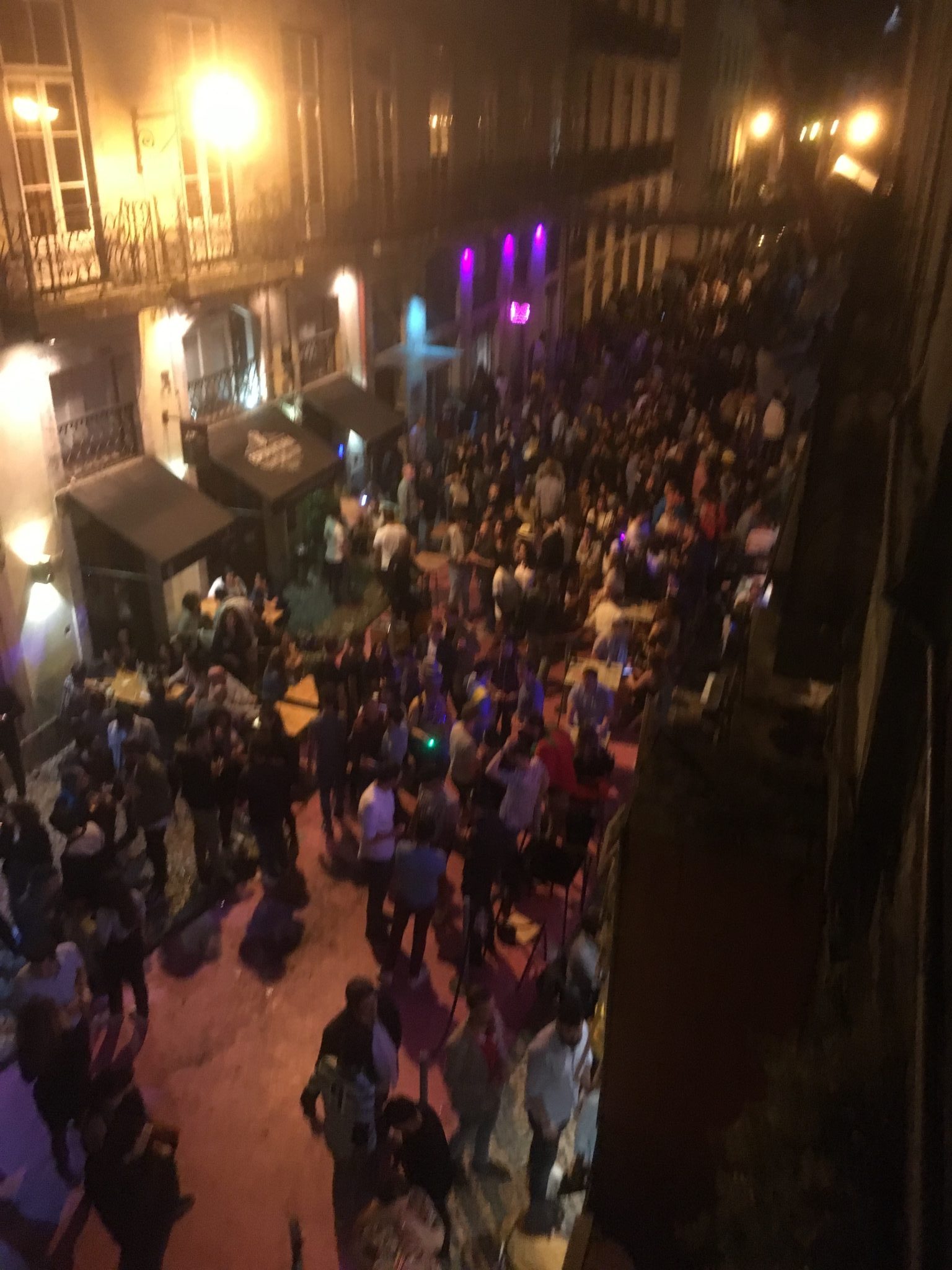As I have remarked before, Lisbon is one of my favourite cities. Period.
Arriving this time to the city in the summer, the vibe was certainly different with an influx of tourists and warm sun beams. The constant breezes keep Lisbon generally cool, but the UV rays can still burn those of us with fairer skin. Keep that in mind while exploring this wonderful place. And, despite a little red on my shoulders, everything about this Lisbon experience still reinforced my love of this city.

Many visitors and travellers I met also remarked that they themselves wanted to move to Lisbon for its relatively cheap prices, scenery, and charismatic, southern European atmosphere. Many in fact do just that. Unlike its neighbour, Spain, Portugal still is somewhat mellow in comparison when it comes to tourism. In contrast to let’s say, Barcelona, which is dealing with crippling over-tourism, Lisbon is still a foodie’s and beach bum’s paradise without too many swarming crowds.
Who can say why this capital has remained so low-key? Whatever the reason(s), it is worth a visit to just see what the fuss is all about. Hopefully, I can provide some insight and convert you to a Lisbon lover as well.
Food
I have written before about Portuguese food and for good reason. The cuisine is clearly Iberian with its bold, rich flavours and additional spiciness at times. There are plentiful amounts of cured dishes that exist as massive portions meant for sharing and tasting.

o peixe – fish
Bacalhau ‘codfish’ is one such staple that chefs present in numerous ways. One of the most famous preparations is as bolinhas ‘(little) balls’, which resembles croquettes. Aside from that, the presentation may consist as simply salted, in a soup or a paté spread!

On the TAP airplane I took into the country, they even served bacalhau with potatoes as the in-flight meal! What a treat. It was a solid 7/10 for airline food standards.

(Photo credits by PintsizedPioneer)
Seafood is also foundational in this gastronomy as a result of Portugal’s historic seafaring ways. ‘Octopus’ or polvo (which is ‘dust’ in Spanish actually (please cf. pulpo for ‘octopus’)) is immensely popular either grilled with potatoes or served raw as a ceviche-like salad. If one is in Portugal, these dishes must be sampled.

(Photo credits by PintsizedPioneer)
Prawns and sardines are also popular, but in the summer, the latter is out of season. At this time, it is best to abstain from them, as the kinds one will be served will just be the frozen variety. Likewise, prawns, although delicious, are often overly exported, so it might be best to opt for other shellfish even in the summer.

Sadly, I learned of this fact after sampling a few myself at my favourite restaurant in Lisbon: Mar ao Carmo.
a pimienta – pepper
One such feature of Portuguese cuisine that I think distinguishes it from Spanish and other similar southern European food cultures is its potential pungency. As a result of its vast colonial empire, Portugal had outposts in South America (Brazil), India (Goa), and throughout Africa (Angola & Cabo Verde … and even more). And therefore, the influence of the spice trade was huge on the cuisine of this colonial state.

(Photo credits by PintsizedPioneer)
Thus, Piri-piri oil is popular with grilled chicken: another common staple. However, pungent flavours abound in the national cuisine in general with spicy sausage, other sauces, and peppers sprinkled throughout menus around the country.
doce – sweet (adj.)
Of course, no trip to Portugal would be complete without eating Pastéis de Nata/Belém. These egg tarts are emblematic of Portugal and in extension Lusophone culture and are found even in Cantonese dim sum via Macanese influence. The one shop that invented them is still operational in Belém on the outskirts of Lisbon proper and is always busy. However, the line moves quickly, so do not be too put off by the crowd all wanting the exact same thing!

(Photo credits by PintsizedPioneer)
As a general trend, Portuguese pastries tend to be eggy, which is no problem for me whatsoever. This feature provides great colouration for the doughs and flavour!
Another treat (to complete a beach day in particular) is bolas, which are sold by vendors for a few Euros. Filled with custard and dosed in sugar, these thick and crispy fried dough pockets are a perfect snack. Another great sweet is pão de Deus or ‘bread of God’, which is as the name would suggest is heavenly!
Happiness and Saudade
A paradox of sorts, it is. How is there simultaneously happiness and saudade or the unique Portuguese form of melancholia in such a place?
Well, one aspect of Portugal that stands out to me is how the dogs exude friendliness. What does that mean?

They want to be petted. Sometimes, they demand it. And, owners are usually fine with strangers petting their pets. In some countries, this practice is not culturally comfortable (i.e. Sweden).
I think that speaks a lot of Portuguese people’s warmness and openness to others. I understand that dogs in particular pick up on their owners’ energy and attitudes. Judging by their dogs’ temperaments, this correlation speaks well for the Portuguese.
a canção – the song
Conversely, Portugal is a terra da saudade ‘the land of saudade‘ where Fado is heard in the streets, particularly in the Alfama region of Lisbon. It is the typical style of folk music that singers belt in bars and taverns and at one time for their sailor friends/lovers who were out to sea. Fado is all about longing. It resembles a mix of the blues and jazz and opera altogether and to hear it live is a magical experience.

I went to the main Fado neighbourhood one night just to hear it live and found myself in a crowded, little bar called Fado Maior and its adjacent restaurant that function as a unit. It was intimate, but busy with many tourists and locals. Be aware that prices at Fado eateries are often quite high as a result of the musical element. Lite fare and wine are all one needs; I suggest eating a larger meal/bifana (a classic Portuguese sandwich) beforehand to save some money.

Another more upscale, indoor venue for Fado is Clube do Fado, also in Alfama. As one might expect, this location is more ritzy and expensive. However, sometimes for a special occasion, this sort of ambiance is preferred.
With saudade in their souls and cores, perhaps that is why the Portuguese seem to exude warmth (at least transitively through their pooches)? They are actively gleeful so that their saudade is not all consuming? For whatever reason, it is easy to feel welcomed in Portugal despite Fado ballads in the streets.
mas – but (conj.)
Nevertheless, some Brazilian friends experience a few issues with some Portuguese individuals. Sociolinguistically, the Brazilian dialect has less prestige compared to the European variety. Some Portuguese do not like their sister Brazilian variants to the point that sometimes they opt for English amongst their fellow Lusophones! This prejudice is kind of ironic given that most people prefer Brazilian Portuguese’s trademark openness (i.e. */dʒi.ˈfi.siw/ in BR v. **/di.ˈfi.siɫ/ in EP) compared to Peninsular Portuguese. Interesting.

However, within the queer community, people are generally more accepting to Brazilian pronunciation.
*The final sound is more rounded and sounds like ‘ew’ in English.
**The final sound is more lateral and more like a typical ‘l’ in English.
Nightlife
Compared to Lund, Sweden (where I was residing prior to visiting), Lisbon is lit af!
With ‘Pink Street’, a bacchanal of tourists, locals, and samosa vendors to Bairro Alto (‘High Neighbourhood’) with its gay bars and various other clubs, Lisbon is active at night with swarths of people. One reason why partying in Lisbon is so popular is that the price of alcohol in Portugal is rather cheap comparatively to other locations in Europe, including its neighbour Spain.
A nice bar to start the evening at is Majong (with hanging bokchoy lights) while Friends is another great venue more for dancing into the night!
That said, it also means that Lisbon gets a little messy after 3AM when most clubs empty out in Bairro Alto and people head to Pink Street.

Personally, at that point in the night, I usually tend to enjoy a few homemade samosas from the various vendors who sell them to drunk partygoers and prefer to head to late night eateries than deal with the drunk, straight stag nights that roam Pink Street in the wee hours. Cacau Da Ribeira is a popular joint for locals to get some sustenance after a long night out and situates itself close by to Cais de Sodre station. I highly recommend their sandwiches and pastries!
A delicacy that is originally from the more northern Porto is the Francesinha or ‘(little) French one’. This sandwich is drowned in a special beer-based sauce with a fried egg and fries. People consume it usually with beer, which may make it a nice addition to an evening out. Or, it also serves as a perfect hangover meal.
Water
Something I missed profusely while living in Lund is water. Water, water everywhere, but there!
Living in Vancouver, I am surrounded by the sea at most points. In Lisbon, the Telus river is a major point of interest, and beaches abound along it and the Atlantic.

(Photo credits by PintsizedPioneer)
Cascais, Carcavelos, Oeiras, and the gay beach across the bridge are all popular spots for people to enjoy the cool ocean waters.
Cascais is the farthest beach from the departure point of Cais de Sodre and also named for the beach town in which it occupies. Food there is somewhat expensive, and the area is highly touristic. The stereotype of people who are from there is equally vapid; many Lisbonites consider residents of Cascais to be shallow and money obsessed, but put together. Very Beverly Hills.
a praha – beach
Caravelos is a majorly popular beach that caters to all clientele. It is a massive expanse that has large enough waves for surfers too. Most people spend a full day here and enjoy bolas from vendors and bring their own alcohol as well to sweeten the atmosphere.

As for the gay beach (Beach 19), it is somewhat difficult to access. Across the bridge, it is more of a full day trip, and not many Lisbonites know of its whereabouts or reputation. Luckily, there is a bus tour that takes people directly to it for a price, which actually given the amount of effort it takes to get there alone, might be worth the mullah.
I did not go to this beach as a result of the distance, but my misterb&b host highly recommends it. It also (unsurprisingly) is a nude beach too, and amongst the grassy dunes, some cruising takes place.
Public Transport
I have praised it before. And, I will praise it again. The metro system in Lisbon is easy and efficient for users. One can purchase a Viva Viagem card at any station and reuse/recharge it for one’s entire stay. However, not all cards are made equal.
One can use the green cards also for travel outside of Lisbon (i.e. to Cascais or Sintra) while the white cards are for Lisbon proper only. The train station ticket kiosks dispense the green cards while most metro stops provide the white cards. However, sometimes, they also produce the green ones. As one might expect by now, the green ones are the most optimal, so try to get one of these babies to not have to change between them.

Aside from the metro system, the trolleys are also iconic to Lisbon’s scenery and heritage. Metro tickets can be used on them, but should be purchased prior for everyone’s ease. Riding one of these beautiful and quirky trams is a must for anyone visiting Lisbon for the first time.
Nothing beats a cute streetcar.
Lusophone Mixedness
One defining feature of Lisbon and Portugal in general is what I describe as Lusophone mixedness. As a result of its former colonies, the Lusophone community is diverse. Portuguese speakers exist as far as Macau and Goa to Mozambique and Brazil. Emigration from Cabo Verde is also prevalent in Portugal, which adds Cabo Verde Creole to the mix of Portuguese-language variants that exist in this space.

Having lived in Sweden for the last year, racial and ethnic diversity is refreshing to witness (and in some ways be a part of) as well as observing the difference in interactions and acceptance of individuals into larger society. Of course, as mentioned prior, some Portuguese do not enjoy the Brazilian dialect (and in extension the Brazilians themselves).
However, compared to the immigrants in Lund (and Sweden in general) who are more segregated and isolated in their neighbourhoods, which then often unjustly are deemed ‘dangerous’ for merely having immigrants, this dynamic does not seem to be as realised in Lisbon.
Perhaps it is a result of the language politics of new immigrants who have Portuguese as an L1 or L2 language already? Are they able to better negotiate their place in society and earn and defend their social capital sooner? I believe that is a larger question and for someone with more experience in sociolinguistics or a sociology field.
juntos – together
Either way, this mixedness of course is beneficial to Lisbon. Aside from rectifying Portugal’s colonial history, the absorption and presence of these other cultures bring in fresh food, music, and perspectives that only enrich the life in Lisbon. The famous Fado singer Mariza was born in Mozambique. Singers Mayra Andrade and Sara Tavares both are connected to Cabo Verde and are fabulous, sultry voices. Although they have not perfected them (at least to Brazilian standards) yet, cairpirinhas are popular refreshments in most bars.
What Lisbon offers is only augmented by this array of incoming cultures. In some way, this admixture is merely a continuation of exchange between and within the Portuguese spheres of influence. At least now, it seems that there is more equity in this cultural melange.
Good Vibes
As one can plainly see, I could sing the praises of Portugal’s capital to no end.

There are of course issues in the country including rising rent prices, petty theft, and prejudices like homophobia and racism in workplace discrimination and classism that still exist. However, Lisbon is undoubtedly a special city and easily beloved by all.
It is hard not to enjoy it, especially in the summer when the temperatures can rise to 35 Celsius. As I have been to the city both in the winter now and the tourist season, I can say I enjoy it more with the buzz of people and a scorching, sunny climate.

However, even in the winter, it is enjoyable. It might be slightly less enjoyable to savour a cotixnha and coffee at an outdoor café, but the prices almost everywhere are leagues cheaper in the winter.

It is hard to go wrong with Lisbon, truly. No matter the time of year, it has its perks. I do not know what it would take for me to fall out of love. I hope to never find out.
Now, I am in Hamburg, Germany. I am beginning my trip down to Milan to travel with Croatian goddess, Nina, to Cyprus and Turkey! Posts are a bit slow coming out, but no matter, I will be trudging along with new updates about Portugal, Sweden, and soon Germany and Italy along with my own linguistics work. I might also share more about my real job … which is of interest as well hopefully. We’ll see. Travel more and safely!

I’ve heard so many great things about Libson. The food looks delicious! I like that you got a taste of everything – I am a sucker for the seafood. Oh wow, Pink Street is something else. Glad you had fun out there!
Nancy ♥ exquisitely.me
Pink Street is … a lot …but also a lot of fun! And, it is! Def go to Portugal if you get the chance — still affordable, beautiful, and delish.
Lisbon is fantastic. Lovely, personal introspection..